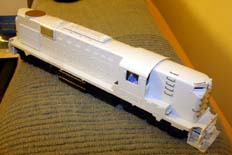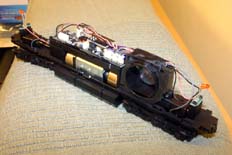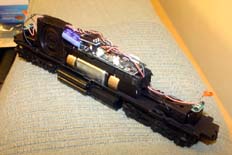Back to Contents
Back to DCC
Link to Sitemap
Broadway Blueline Alco RSD15
Item 22093, High short hood, Undecorated

The Broadway Blueline locos are a series of models which seem to have been derived from the original Broadway Limited Imports 'Paragon' series. They come with a sound system fitted and are described as 'DCC Ready' - ready for the installation of a third-party decoder if operation on DCC is required. We've found this approach presents both advantages and disadvantages...
As is becoming traditional on this 'site, we'll start with the good stuff - the first of which is very obvious. It looks correct. The Alco road switchers are very distinctive in shape and style; which has been beautifully captured here. The detailing of the ABS bodyshell is superb - amongst the best I've seen. This, in turn, is enhanced by a number of seperately applied details such as formed wire steps and etched radiator and cooler grilles. The engine hatch is a removable plastic insert which clips in; this presents one way to get a decoder in if you're worried about taking the bodyshell off the model.
A good start for appearance then. So what about the chassis? Well it's heavy, mostly die-cast and runs very well. As the running-in progressed the performance improved further resulting in a loco that after a couple of hours running is now amongst the smoothest and quietest locos I have. The bogie sideframes are nicely detailed too!

Taking the body off (itself a careful operation!) reveals the interior of the model. Most obvious is the large speaker in its die-cast enclosure. As can be seen, the motor is set low into the frame allowing the sound controller card to sit on top of it. Centrally on the card is a standard 8-pin NEM652 DCC socket which will allow many decoder types to be fitted. As expected, our favourites weren't among the list of suggested decoder types.
Sound and running trials on analogue control
This is quite interesting - sound-equipped analogue locos are, by their very nature, unusual. What's more unusual is to find an analogue sound loco that does more than 'growl' (in the case of a diesel) or 'chuff' (for a steam loco). In essence what you've got here is a fully-featured DCC-compatible sound decoder, so I guess it's not really suprising that it works well.
What is very suprising is the level of co-ordination between the motor running and the sound coming out of the loco. In some ways it's like driving one of the better DCC sound-equipped decoders on analogue. Gentle advancing of the throttle will get the engine to start, rev-up and then the loco moves off. Reducing the throttle will slow then stop the loco before the sound cuts out. Driving the loco with a conventional controller with a 'centre off' control knob is likely to be a bit irritating as the sound will cut out every time you want the loco to reverse. Not such a problem during my test though, as the KPC uses a switch to reverse. Similarly I can't imagine that operation with a feedback controller is likely to be a good idea as it could cause problems for the sound decoder - it won't help the running either as the model's motor won't be directly linked to the controller.
What I haven't talked about yet is the sound. I'll come to the actual sound quality a bit later on, but here it's worth mentioning that the sound features (bell, horns, etc.) can only be accessed if you purchase the 'Quantum Controller' from Broadway. The settings for the sound performance (including things like volume) can be programmed using a DCC command station and will apply even when the loco is running under analogue control. There are also a set of seperate settings which will apply when the loco is running under analogue control (with or without a DCC decoder installed).
Sound and running trials on DCC control

This is interesting. For a start there's a lot of info in the manual about the fitting of a DCC decoder, including a short list of recommended types. There is also a pointer for the installation of other decoders, which is worth getting your head round if you want to fit a decoder type that isn't listed in the instructions. I went for an ESU LokPilot v3.0, you can click the link if you want to see why. This isn't one of the recommended decoders mentioned in the instructions, but the smaller ESU LokPilot Micro is. I wanted to use a higher-current decoder than the LokPilot Micro, so the LokPilot seemed the natural choice. However, the decoder fitting instructions provided by Broadway hint at a problem with some locos if the eighth (green) wire from the decoder remains attached to the plug. Careful cropping off the wire soon got the decoder in and working properly.
You're then in the fun and games of having to programme two decoders in one loco. This is more of a problem with ESU (and some other) decoders as there is no way to 'lock' specific decoders working on the same address. To put it simply Broadway have assumed the use of a decoder with features over and above those within the DCC standards. Personally, I'd rather there be a switch somewhere in the body to physically switch the loco between the three options; programming the sound decoder, programming the running decoder and actual running. But never mind - the alternative is to have a decoder tester, or second loco with an 8-pin NEM652 socket, available in order to swap the ESU decoder out for programming.
I suppose that now is a good time to raise the issue of programming the Broadway decoders. Certainly programming on the Lenz Compact was out - no joy at all. On the SPROG, the sound decoder programmed most of the time, but I didn't always get the acknowledgement 'beep'. However, this problem has been solved with recent (2009) updates to the SPROG firmware and JMRI V2.2 or later. On the JMRI 'DecoderPro' software under the 'SPROG' tab you can find 'Console'. This has a specific option for programming BlueLine locos. As an aside it may also work if you're having trouble programming the odd QSI loco (Atlas 'Gold', Proto 2000, early Broadway 'Paragon' etc. sound-equipped locos all come with QSI sound technology)...
Sound operation and quality
So we've popped the loco out of its box; gone 'ooo' and 'aah' about it's appearance, run it in on analogue, been impressed by its weight and running. And got a decoder into it. So now what?
With the model on the track and the Lenz Compact controller to hand I hit the first problem. The sound start is on f9. The Compact only goes up to f4 and many other controllers only go up to f8. I'd have liked to re-map the function to a lower number, but f9 is as low as it'll go. Thankfully, there's a 'get around'; address the loco and whack the throttle open and then shut it again. The loco will now go through its start-up sequence.
Thankfully, with a recently updated Lenz SET90 to hand, it starts fine and shuts down properly too. So how does it sound? In short it's absolutely marvelous. For a start it sounds like an Alco 251 series engine and it's got reasonable bass too - especially when you consider the size of the speaker. The performance of the sound can be very closely tailored with whichever DCC decoder you decide to fit, or your chosen approach to running on analogue control, thanks to a very comprehensive set of CVs. The mechanism doesn't intrude with noise or or vibration - with a good-quality analogue controller or the ESU LokPilot the running is both smooth and quiet. The only concern with the loco in all honesty is the programming - with two decoders it's a fiddle and there's a lot of it to do in order to get the best running and sound out of the model.
But it can't be that bad - I've subsequently bought another Broadway Blueline loco (an EMD SD7) and if they did other locos I was interested in, I'd probably get more.
Conclusions
The Positives
The main one is the sound quality - probably the best I've heard, and it sounds like the correct engine rather than a 'generic EMD'. Being able to fit a pretty-much free choice of decoders. Excellent appearance (though this aspect varies depending on the model and the RSD15 seems particularly good in this respect.). Smooth, quiet mechanism.
The Negatives
Programming is a fiddle with loads of CVs, two decoders to worry about and the compatibility issues between the BlueLine sound decoder and some command stations. Possibly having to modify the wiring on the decoder to get it to fit.


